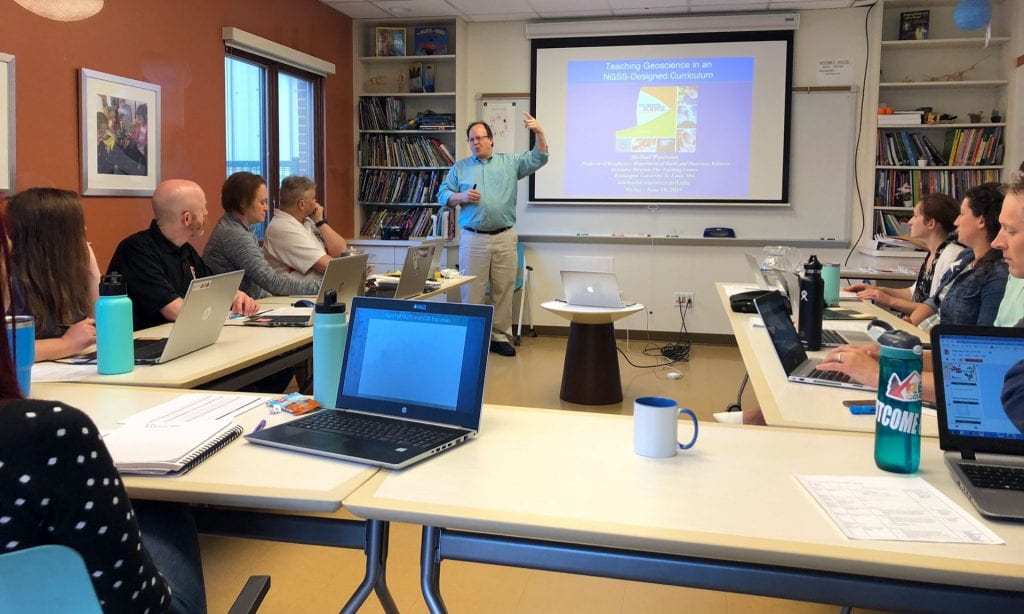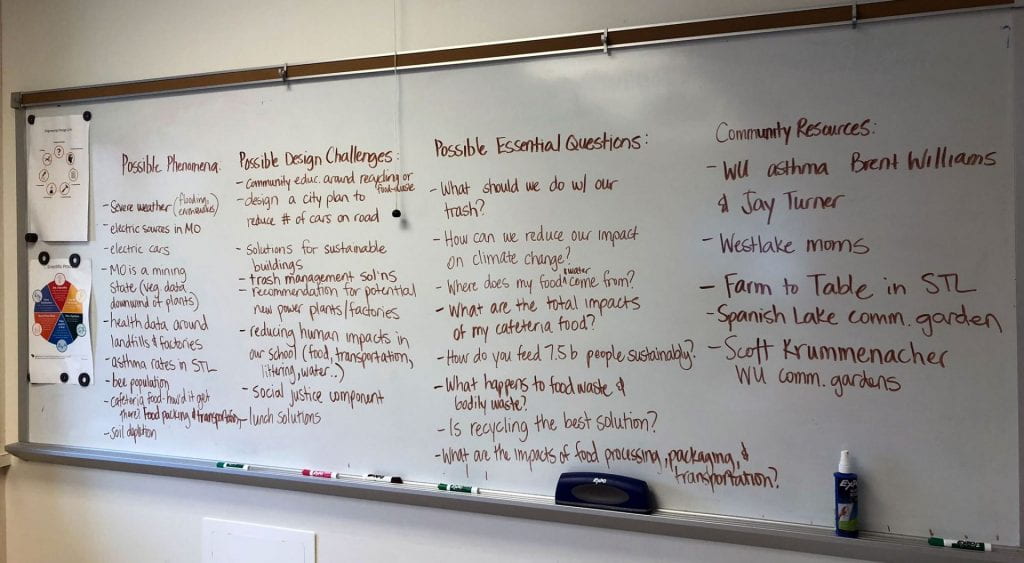A two-year collaboration between teachers at the Ritenour School District and faculty and staff from Washington University in St. Louis culminates this year with four completely new high school science courses.
Instructional specialists with WashU’s Institute for School Partnership (ISP) and Michael Wysession, Professor of Earth and Planetary Sciences and an expert on the Next Generation Science Standards (NGSS), partnered with middle and high school Earth and Space Science teachers from Ritenour to design and develop the courses. The teachers were paid for their participation through funding Ritenour received to develop these high school courses, as well as an eighth-grade advanced version.

ISP Executive Director Victoria May said Wysession was integral to the curriculum development process, supporting performance expectations and brainstorming and writing storylines.
“He sparked passion and brought expertise in content knowledge, while the ISP instructional specialists instilled pedagogy and NGSS curriculum tenets,” May said.
Initially, the group came together during a two-day summer institute in 2019. They identified the big ideas related to the standards and storylined the curriculum. After the summer institute, a smaller cohort of teachers took the storylines they had drafted and wrote the science lessons.

“Working with the ISP on this science curriculum has been a dream come true.”
Amanda Thouvenot, Hoech Middle School
“Working with the ISP on this science curriculum has been a dream come true,” said Amanda Thouvenot, an eighth-grade Earth and Space Science teacher at Hoech Middle School, who helped create the courses. “I know it sounds super cheesy, but making science hands-on is my passion.”
Thouvenot said working with Wysession was an amazing experience. She said his content knowledge and accessibility were invaluable to the process.
Tracy Weber, a science teacher at Ritenour High School, concurred. She participated in the storylining and writing of the units. Of Wysession, she said in addition to his wealth of knowledge, he was very entertaining to listen to. She said he was always open to helping the teachers and answering their questions.
Each of the science units has a driving question, a storyline and culminates with a performance task. The four units are aligned to NGSS and Missouri Learning Standards (MLS). The initial work involved adapting two existing mySci science units, later followed by the creation of two brand new units. The two new units are related to climate change and human impact with a focus on the geologic history of local sites, Cahokia Mounds and the formation of the Mississippi River. Students explore the food system unit, including food deserts and food waste, through the lens of cafeteria food.
“These science units push students to become agents of change and also to strategize solutions. The problems being tackled are big and we want kids to feel like they have the ability, even as young people, to start making a change in their community.”
Lauren Ashman, ISP instructional specialist
“These units really push students to become agents of change and also to strategize solutions. The problems being tackled are big and we want kids to feel like they have the ability, even as young people, to start making a change in their community,” explained Lauren Ashman, ISP instructional specialist.
Student involvement in developing the science curriculum was crucial to the process. Actual student questions helped guide the phenomena choices.
“The collaboration started with a student survey to generate unit topic ideas,” Ashman said. “Topics mentioned were pollution, global warming and climate change. The student surveys were an excellent way to make curriculum relevant, accessible and equitable to target student groups. Earth Science is what got me interested in science. Maybe that’s their window into science.”
Richard Tibbs says implementing the science courses in his classroom has been a dream. He said they’re succinct and the accompanying resources are well thought out.
“We have a stream table that has gravel in it, and we got a water pump to show how the water changes the land. They got to see a real-life example of how rivers work, and how they transform the land over time,” he said. “The students had never seen this stuff happen before and were amazed by it. That was pretty cool.”
Thouvenot loves doing the human impacts unit with her students. She takes them to the cafeteria where they fill a plastic container with soil and food waste to create their own landfill. They can compare open systems and closed systems and whether or not an item is biodegradable.
“It’s neat to see everything come full circle because I was there when these things were being written into the curriculum and seeing it executed is an incredible process.”
In October 2021, ISP instructional specialists and Ritenour teachers started writing the final unit which is about space. It will roll out to students in January. These four science units will be launched as an open educational resource.
Media contact: Myra Lopez